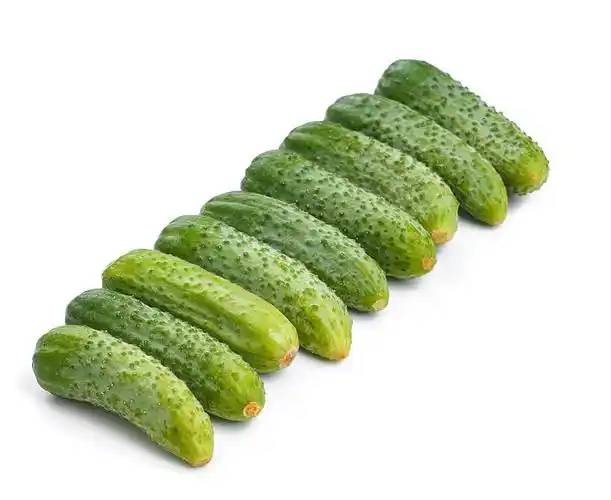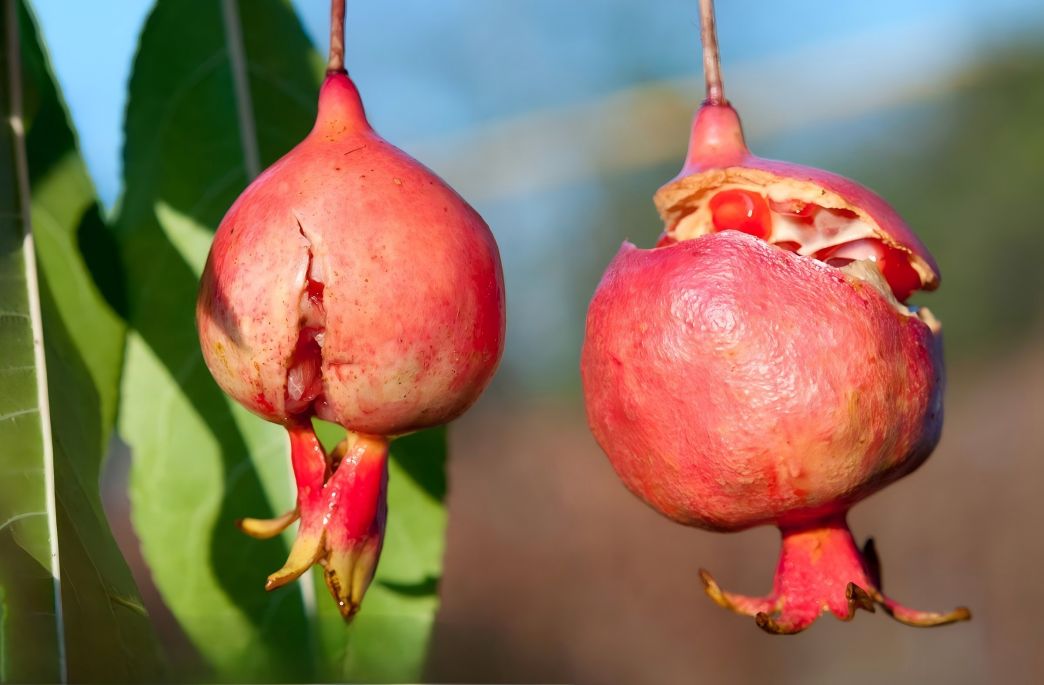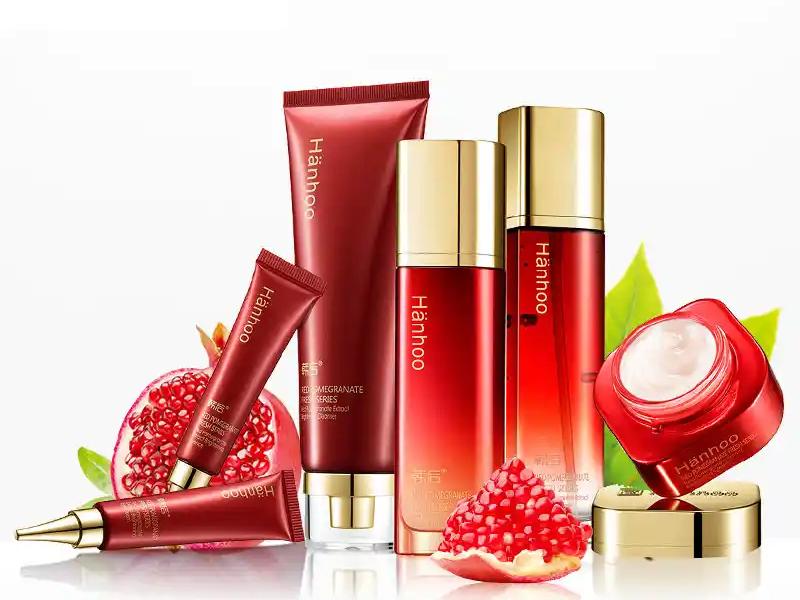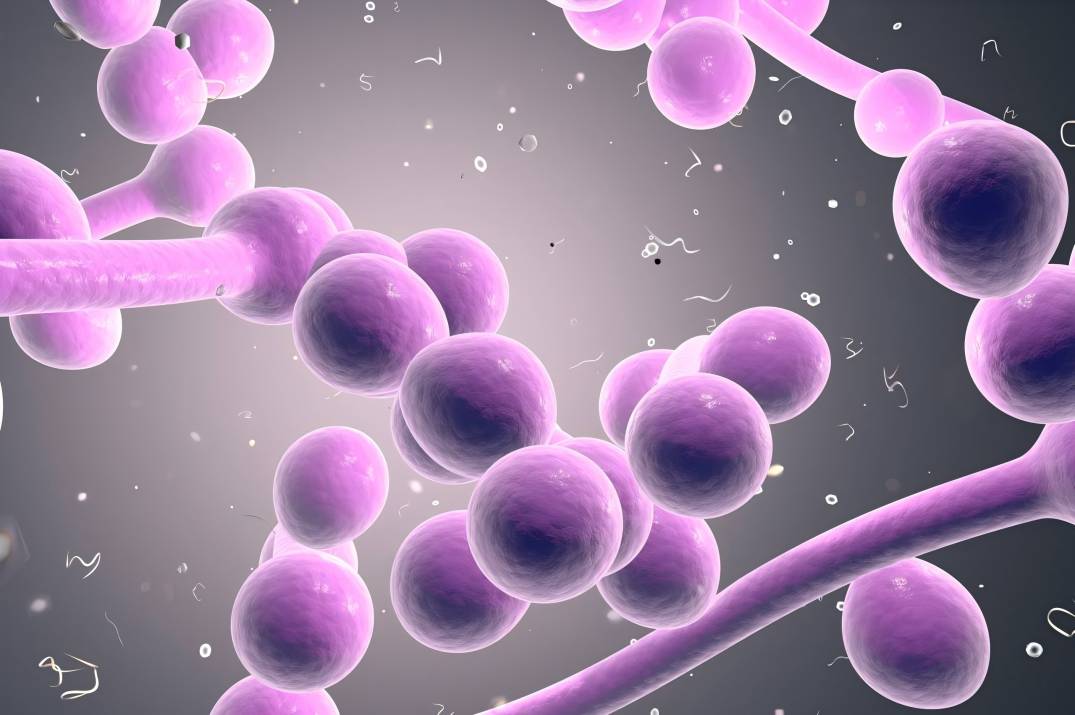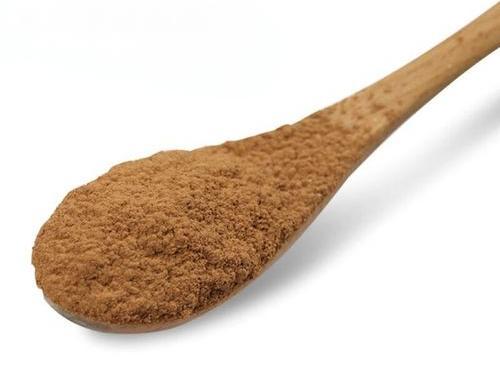What Are the Benefits of Pomegranate Skin in Food Preservation?
Pomegranate (Punica granatum L) is a deciduous shrub or small tree belonging to the family Punicaceae, native to the Balkans to Iran and adjacent regions, and cultivated worldwide in temperate and tropical regions [1]. Pomegranate is a dual-purpose medicinal and edible plant. The pomegranate peel is the dried rind of the pomegranate, accounting for 20% to 30% of the total weight of the pomegranate. It can be used in medicine and has a sour and astringent taste. It is warm in nature and has the function of astringing the intestines and stopping bleeding. It can treat a variety of acute and chronic dysentery and hemorrhoid bleeding [2]. It contains a variety of physiologically active substances, including tannins (polyphenols), flavonoids and their glycosides, alkaloids and organic acids, etc. [3].
The pharmacological effects of pomegranate peel extract mainly include antiviral, antibacterial, antitumor, antioxidant, anti-cardiovascular disease, immune regulation and stomach protection, etc. [2-3]. Pomegranate peel has a broad-spectrum antibacterial effect, and has a significant inhibitory effect on most gram-negative and gram-positive bacteria, with the strongest effect on Staphylococcus aureus and Shigella dysenteriae; it also has a varying degree of inhibitory effect on various fungi and molds. It is currently believed that the inhibitory effect of pomegranate peel on a variety of bacteria, fungi and molds may be related to its tannin (polyphenol) content, such as ellagic acid and other tannin components. Pomegranate peel has good antioxidant effects and broad-spectrum antibacterial effects, and can be used in the preservation and freshness of food. This article focuses on the following review of the research progress of the antibacterial effect of pomegranate peel extract and its application in food preservation at home and abroad in the past decade.
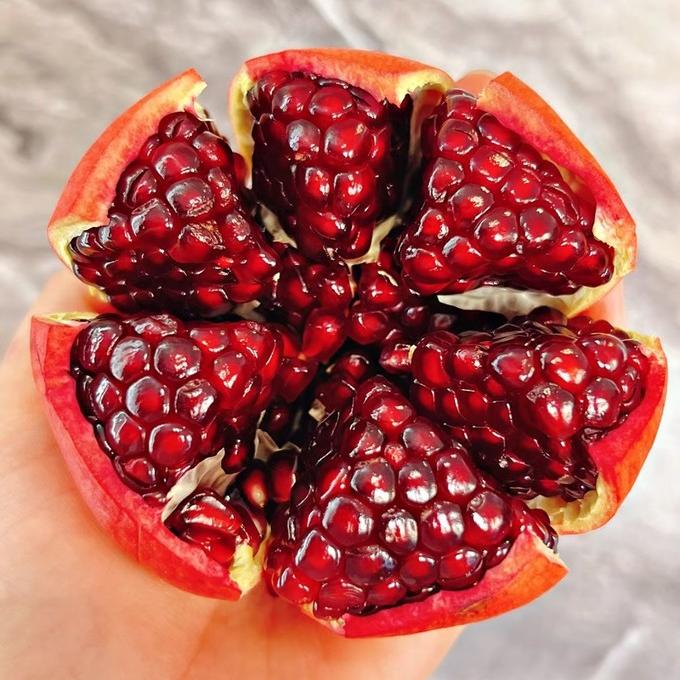
1 Antibacterial spectrum of pomegranate peel
Pomegranate has a broad-spectrum antibacterial effect and has a significant inhibitory effect on most gram-negative bacteria, gram-positive bacteria, various fungi and molds. However, the antibacterial activity of extracts from different parts of pomegranate varies. Many studies have shown that pomegranate peel extract has stronger antibacterial activity than other parts, and that the antibacterial activity of pomegranate peel extract is related to its total polyphenol content. Dahham et al. [4] compared the antibacterial activity of 80% methanol extracts from different parts of pomegranate and found that pomegranate peel extract had an inhibitory effect on seven bacteria: Bacillus coagulans, Bacillus cereus, Bacillus subtilis, Escherichia coli, Klebsiella pneumoniae, Pseudomonas aeruginosa, and Staphylococcus aureus. The antibacterial activity was stronger than that of pomegranate seed, pomegranate juice, and pomegranate whole fruit extract, and the inhibition of Staphylococcus aureus and Aspergillus niger was the strongest.
Fawole et al. [5] studied the effect of 80% methanol extracts from the pericarp of seven pomegranate varieties on two gram-positive bacteria (Bacillus subtilis and Staphylococcus aureus) and two gram-negative bacteria (Escherichia coli and Klebsiella pneumoniae). The results showed that the pericarp of pomegranate of different varieties had a strong inhibitory effect on the four bacteria, with a minimum inhibitory concentration (MIC) concentration range of 0.2 to 0.78 mg/mL. Lu Xueying et al. [6] studied the antibacterial activity of four different concentrations of ethanol crude extracts and two types of polyphenol refined products from Xinjiang pomegranate peels, and found that the crude extracts (22% to 32% polyphenol content) had poorer antibacterial activity than the polyphenol refined products (65% and 78% polyphenol content). The pomegranate peel polyphenol refined products had a good inhibitory effect on Staphylococcus aureus, Staphylococcus epidermidis, Enterococcus faecalis, Enterobacter cloacae, Shigella dysenteriae, Salmonella typhi and Proteus vulgaris. The MIC ranges from 0.35 to 12.5 mg/mL, indicating that the antibacterial activity of pomegranate peel extract is directly related to the polyphenol content.
Chen Xiaojuan et al. [7] also showed that the MIC of pomegranate peel total polyphenols in vitro against Staphylococcus aureus was 3.9 mg/mL and the minimum bactericidal concentration (MBC) was 7.8 mg/mL, and the MIC against Escherichia coli was 15.6 mg/mL and the MBC was 31.25 mg/mL. Zhou Benhong et al. [8] studied the inhibition of different eluted components of pomegranate peel extract by HP-20 column chromatography on gonococci and found that the 10% and 20% methanol eluted components had the best bacteriostatic effect, with a MIC of 1.25 to 2.5 mg/mL. The MIC of pomegranate peel extract [9] against Staphylococcus aureus, Salmonella typhimurium and Salmonella enteritidis is 31.25 mg/mL, 62.5 mg/mL and 250 mg/mL, respectively. The antibacterial effect of pomegranate peel extract on the same strains varies among different studies. This is because the extraction solvent and the subtype of bacteria can affect the antibacterial effect of pomegranate peel.
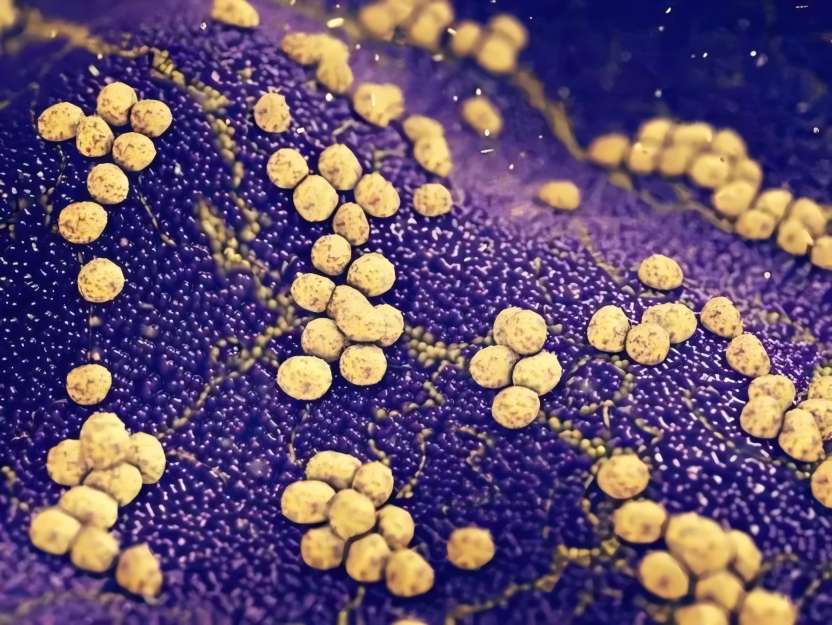
Pomegranate peel tannins and flavonoids are two main different types of polyphenolic components. Yang Lin et al. [10] compared the differences in the antibacterial activity of pomegranate tannins and flavonoids against Staphylococcus aureus, Shigella dysenteriae, Salmonella, Escherichia coli, Pseudomonas aeruginosa and Candida albicans in vitro. The results showed that both flavonoids and tannins have antibacterial effects, but tannins have stronger antibacterial activity than flavonoids.
The MIC values of the flavonoids for the above six bacteria were 62.5 to 500 μg mL; while the MIC values of tannin components against the above 6 bacteria are 3. 9 to 62. 5 μg mL. The main antibacterial tannin active ingredients in pomegranate peel are punicalin and punicalagin. Eliana et al. showed that the active ingredient of pomegranate peel that inhibits two species of Candida (Candida albicans and Candida parapsilosis) is punicalin [11]; the active ingredients of pomegranate [12] that inhibit Staphylococcus aureus are punicalin and punic acid. Pomegranate peel water extract can significantly inhibit Alternaria alternata, Phytophthora capsici and Fusarium oxysporum. Its antibacterial activity is related to the content of total pomegranate polyphenols (such as punicalin and gallic acid), with punicalin as its main antibacterial tannin active ingredient [13]. Further research is needed to isolate and identify the antibacterial active ingredients of the flavonoids in pomegranate peel.
Pomegranate peel extract also shows good inhibitory effects on pathogens of hospital infections. Metallo-beta-lactamase (MBL)-producing and non-MBL-producing strains of Acinetobacter baumannii and Pseudomonas aeruginosa are common hospital pathogens. Pomegranate peel extract [14-15] has a strong inhibitory effect on these pathogenic bacteria. Among them, Acinetobacter baumannii is more sensitive to pomegranate peel extract. The MIC of pomegranate peel extract against Acinetobacter baumannii is 0.5 mg mL, and the inhibition rate of Acinetobacter baumannii at a concentration of 2.0 mg mL is over 93%. and 100% at 3.8 mg mL; the inhibition rate of Pseudomonas aeruginosa at 15.6 mg mL was 93%, and its MIC against Pseudomonas aeruginosa was 7.8 mg mL.
Abdollahzadeh et al. [16] studied the inhibitory effect of pomegranate peel methanol extract at different concentrations on several oral pathogens. It was effective against Staphylococcus aureus and Staphylococcus epidermidis at low concentrations (4 mg mL), and against Lactobacillus acidophilus, Streptococcus mutans and Streptococcus salivarius. However, it is not effective against Actinomyces viscosus and Candida albicans. Pomegranate peel 70% ethanol extract [17] also has a good inhibitory effect on some strains isolated in the clinic. The diameter of the inhibitory zone of Candida albicans, Staphylococcus aureus, Bacillus subtilis black variety, Mycobacterium tuberculosis, Streptococcus pneumoniae, Bacillus cereus, Proteus Enterococcus, Klebsiella pneumoniae and other bacteria have a diameter of more than 7 mm. The MIC determination results show that Candida albicans and Streptococcus pneumoniae are most sensitive to pomegranate peel ethanol extract, with MICs of 25 mg/mL and 50 mg/mL, while Proteus and Klebsiella pneumoniae are most resistant, with MICs of 400 mg/mL.
Hu Wei et al. [18] studied the antibacterial effect of pomegranate peel water extract on two strains of Helicobacter pylori and found that it was effective against both metronidazole-resistant and sensitive strains, The MICs were 29.9 mg/mL and 28 mg/mL, respectively. The bacteriostatic diameter of 100 mg/mL pomegranate peel methanol extract against Escherichia coli, Salmonella typhi and Shigella dysenteriae was 26 mm [19].
Pomegranate peel extract can also inhibit animal pathogenic bacteria and can be used for poultry disease control. Pomegranate tannins [20] can inhibit E. coli in chickens. Feeding 100 g of pomegranate tannin granules per chicken can reduce the mortality rate of E. coli disease in chickens. The mortality rate of chickens fed pomegranate tannins was 6.5% (positive control 15.3%), and the cure rate was 59.2%. When used in combination with Shuanghuanglian powder, the antibacterial activity is even stronger. When granules of pomegranate peel tannins are used in combination with Shuanghuanglian to treat E. coli disease in chickens, the cure rate and mortality rate are the same as those of the enrofloxacin group. Traditional Chinese medicine tannin granules can be used to treat bacterial diseases in chickens instead of Western medicine, overcoming the shortcomings of western medicine, such as the easy production of drug residues and drug resistance. Tayel et al. [21] used an extract aerosolization method to study the fungicidal effect of pomegranate peel extracts in different solvents on Candida albicans. The results showed that pomegranate peel aerosols had a good fungicidal effect, and pomegranate peel aerosols can be recommended for use in hospital wards, poultry and meat factories, canning boxes, food preparation areas, and other places for disinfection.
Vitamin C (Vc) and some metal salts can affect the antibacterial effect of pomegranate peel. Yehia et al. [22] studied the effect of Vc and metal salts on the antibacterial activity of pomegranate peel extract and found that Vc and pomegranate peel were only effective against Escherichia coli and Proteus, MnSO4 and pomegranate peel were only effective against Saccharomyces cerevisiae, CuSO4 and pomegranate peel were only effective against Brucella, ZnSO4 and pomegranate peel were only effective against Bacillus subtilis, Brucella and Staphylococcus aureus; the antibacterial activity of Vc, metal salts and pomegranate peel was weakened or disappeared when the three were combined.
2 Extraction of antibacterial substances from pomegranate peel
The antibacterial effect of pomegranate peel extract is affected by many factors, such as the place of origin, the harvest season, the drying method and the extraction method. The antibacterial activity of extracts prepared with different solvents is different. Solvents with high polarity, such as methanol and ethanol in different concentrations, are commonly used extraction solvents.
Ruoshaogang et al. [23] studied the effects of different extraction methods (microwave extraction, ultrasonic extraction and reflux extraction) and extraction solvents (water, 40% ethanol, 60% ethanol and acetone) on the inhibitory activity of pomegranate peel against Staphylococcus aureus and Escherichia coli. It was found that the antibacterial effect of microwave and ultrasonic extraction was better than that of heating and reflux extraction, and 60% ethanol is the most suitable extraction solvent. Wang Ling et al. [24] screened the optimal process conditions for microwave-assisted extraction of pomegranate peel polyphenols and their inhibitory effects on Staphylococcus aureus, Proteus vulgaris and Bacillus cereus. The extraction power was 385 W, the liquid-to-solid ratio was 1:25 (g:mL), the extraction time was 120 s, The number of extractions was 3, and the sample was 60-80 mesh. The conditions were as follows: the highest polyphenol extraction rate, the minimum inhibitory concentration against Staphylococcus aureus, Proteus vulgaris and Bacillus cereus were 0. 80, 1. 60 and 0. 40 g mL, respectively.
Song Weiwei et al. [25] studied the extraction of polyphenolic compounds from pomegranate peel by microwave-assisted method and its inhibitory effect on Escherichia coli and Bacillus subtilis. The optimized extraction conditions were: microwave power of 242 W, liquid-to-material ratio of 1:35, 40% ethanol, extraction time of 60 s, extraction for 3 times, The yield of the crude polyphenol extract was 26.52%. The pomegranate peel polyphenols obtained by extraction have a good inhibitory effect on Escherichia coli and Bacillus subtilis. The diameter of the inhibition zone at a concentration of 1 mg/mL was 1.15 cm and 1.25 cm, respectively; the minimum inhibitory concentrations were 0.5 mg/mL and 2 mg/mL, respectively.
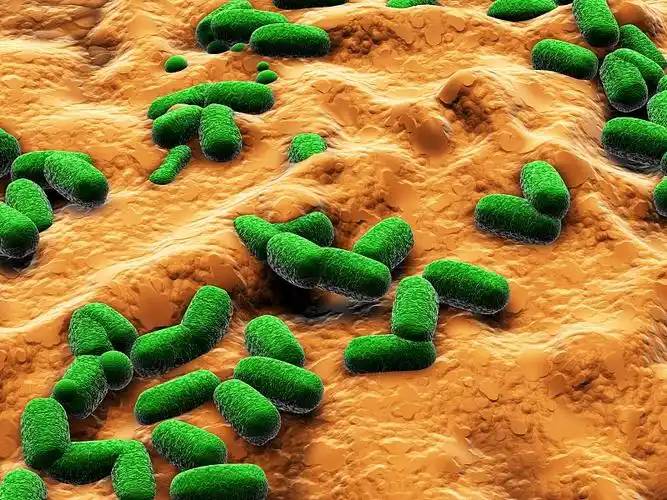
Liu Yin et al. [26] studied the antibacterial inhibition of pomegranate peel extract against Staphylococcus aureus by heating and refluxing the extract. They concluded that the optimal conditions for the antibacterial inhibition of pomegranate peel extract were an extraction temperature of 95 °C, an extraction time of 8 h, and an extraction liquid-to-material ratio of l:4 (g:mL), with an antibacterial inhibition zone of about 13 mm. Guo Xiaoping et al. [27] studied the extraction process of tannins from pomegranate peel and determined that the optimal extraction process conditions were a liquid-to-material ratio of 1:40, a temperature of 90 °C, and a time of 40 min; the tannin content of the pomegranate peel was 17.3%. Pomegranate peel tannin extract has a strong inhibitory effect on Staphylococcus aureus (Gram-positive bacteria), with a bacteriostatic zone of 15.9 mm. It also has a certain inhibitory effect on Gram-negative bacteria (Escherichia coli, Pseudomonas aeruginosa), with a bacteriostatic zone of 9.0 to 9.8 mm. However, it has no significant inhibitory effect on molds (Candida albicans, Aspergillus niger, Penicillium) had no significant inhibitory effect.
Kong et al. [28] studied the antibacterial activity of extracts of pomegranate peel in different solvents (water, 60% ethanol, 90% ethanol) and petroleum ether, ethyl acetate, and n-butanol extracts against three bacteria and 14 fungi in vitro. All crude extracts had varying degrees of inhibitory effects on the three bacteria and 10 of the fungi. In particular, they had a significant inhibitory effect on common food pathogens such as Staphylococcus aureus, Escherichia coli, and Candida albicans. They also had a good inhibitory effect on common plant pathogenic fungi such as apple rot, cucumber blight, tobacco red spot, strawberry fusarium, cabbage black spot, apple rot, and Fusarium oxysporum f. sp. lycopersici. However, the activity of different solvent extracts varies. Among them, 60% ethanol has the strongest bacteriostatic activity, and 60% ethanol is the most suitable extraction solvent. Negi et al. [29] studied the antibacterial activity of acetone, methanol and water extracts of pomegranate peel against Bacillus cereus, Bacillus coagulens, Bacillus subtilis, Staphylococcus aureus, Escherichia coli and Pseudomonas aeruginosa. The acetone extract was the most active, with a MIC concentration of 150 to 200 ppm, while the water extract was the least active, with a MIC concentration of 400 to 700 ppm.
Qu Jipeng et al. [30] compared the effects of five different drying methods on pomegranate peel extracts in inhibiting Staphylococcus aureus and Escherichia coli, and found that microwave heating and drying had the best antibacterial effect, followed by drying in an oven at 50 °C, then drying in an oven at 100 °C, and the worst effect was drying in the sun. This shows that the antibacterial effect of mechanical drying (microwave and oven) is better than that of natural drying (natural air drying and sun drying), and that the antibacterial effect decreases with the increase of drying temperature. Mechanical drying has the advantages of short drying time and instant high temperature, which can reduce the oxidation of pomegranate peel polyphenols.
3 Application of pomegranate peel in food preservation
Pomegranate peel has good antioxidant, free radical scavenging, lipid peroxidation inhibition and broad-spectrum antibacterial effects. It can be used to preserve foods such as milk, soy sauce, fruits, vegetable oil and meat, and there are more and more reports on related application research.
Pomegranate peel extract has an inhibitory effect on decaying bacteria such as those in fruits and vegetables. Qiao Shuhua et al. [31] studied the inhibitory effect of methanol, chloroform and hexane. Qiao Shuhua et al. [31] studied the inhibitory effect of methanol, chloroform and hexane extracts of pomegranate peel on the cucumber wilting pathogen. The methanol extract had a good inhibitory effect on the cucumber wilting pathogen, with an inhibition rate of 34.18% at the lowest mass concentration of 6.25 g L and as high as 83.54% at 100 g L.
The methanol extract was subjected to systematic solvent extraction (petroleum ether, chloroform, ethyl acetate and n-butanol in that order) to obtain solvent extracts for each solvent, and their antibacterial effects on Fusarium oxysporum f. sp. cucumerinum, Colletotrichum gloeosporioides, Rhizoctonia solani and Botrytis cinerea were determined. Solvent extracts of different polarities all had antibacterial effects, with the most polar n-butanol extract having the best effect. The antibacterial activity against the four pathogens is relatively strong, with EC50 values of 49. 22 g L, 26. 20 g L, 41. 80 g L and 52. 68 g L, respectively, indicating that the antibacterial active ingredients in pomegranate peel are mainly concentrated in the n-butanol extract. The pomegranate peel n-butanol extract also showed a significant control effect on tomato gray mold. A 100-fold dilution of the extract had a protection effect of 46.41% against gray mold and a treatment effect of 48.00%, both of which were at the same significant level as the control chemical agent thiophanate-methyl 300-fold dilution treatment [32].
Pomegranate peel flavonoid extract [33] has an inhibitory effect on bacteria, molds and yeasts. Pomegranate peel flavonoid extracts at 10 mg/mL and 20 mg/mL have a significant inhibitory effect on lactic acid bacteria and Staphylococcus aureus, with inhibition zone diameters of 11 cm and 13 cm, respectively; the inhibitory effect on Escherichia coli and molds is second, with inhibition zones of 9 cm and 8 cm respectively; it had a weaker inhibitory effect on yeast. Pomegranate peel flavonoid extract has also been shown to have a good bacteriostatic effect when used in milk storage. The total number of bacteria in milk with added pomegranate peel flavonoid extract is much lower than in milk without added extract, and the change in the total acidity of the milk is relatively small. The effect is better than that of the food preservative sodium benzoate, indicating that pomegranate peel flavonoids can be used to preserve milk.
Shao Wei et al. [34] studied the inhibitory effect of pomegranate peel extract on Escherichia coli and Staphylococcus aureus. The antibacterial effect of adding 1.2% pomegranate peel extract to soy sauce is better than adding 0.1% sodium benzoate and potassium sorbate, and it does not damage the original flavor of the soy sauce. Therefore, it is possible to use it as a natural plant preservative instead of chemical preservatives such as sodium benzoate or potassium sorbate for food preservation.
Zhang Lihua et al. [35] studied the preservation effect of pomegranate peel extract on fresh strawberries, and compared the preservation effect of 1.25% chitosan solution, 1% pomegranate peel extract, and 1.25% chitosan + pomegranate peel extract compound solution immersion treatment on fresh strawberries. They found that all three treatments could reduce the weight loss rate, softening and decay rate and MDA content, and delay the decline of titratable acid, soluble solids and Vc mass fraction. Among them, the 1.25% chitosan + pomegranate peel extract compound solution treatment has the best effect, which can extend the shelf life of strawberries placed at room temperature for 1 to 2 days.
Pomegranate peel extract added in an appropriate amount to sunflower oil can effectively remove free radicals in oil, thereby extending the shelf life of vegetable oil [36]; Devatkal et al. [37] studied the inhibitory effect of pomegranate peel water extract on a strain of Pseudomonas aeruginosa isolated from poultry meat. Three different antibacterial methods (agar diffusion method, broth dilution method and growth inhibition method) all showed that pomegranate peel extract had a strong inhibitory effect on Pseudomonas stutzeri, which was stronger than 30 mg/mL of tetracycline and vancomycin, and 10 mg/mL of streptomycin, with a significant difference. Pomegranate peel extract can reduce the synthesis of Pseudomonas stutzeri proteins, so it can be used to preserve poultry meat in the cold.
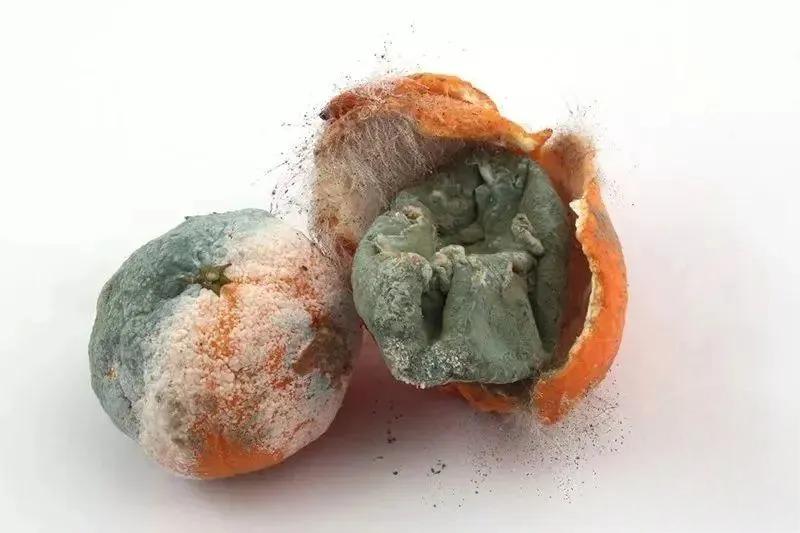
Pomegranate peel extract can also control the oxidation and rancidity of chicken by inhibiting some food spoilage bacteria and lipid peroxidation, thereby extending the shelf life of refrigerated chicken [38]. Naveena et al. [39] added pomegranate peel extract to diced chicken, which improved the freshness and eating quality of the chicken, increased the polyphenol content in the chicken, reduced malondialdehyde, inhibited lipid peroxidation, thereby prolonging the shelf life of the chicken when refrigerated. Pomegranate peel extract can also inhibit lipid peroxidation in goat meat and prolong its shelf life [40-41].
4 Prospects for research on the application of pomegranate peel as a food preservative
The broad-spectrum antibacterial efficacy of pomegranate peel, as well as its antioxidant and lipid peroxidation inhibition effects, lays an intrinsic foundation for its development as a food preservative. In order to widely apply it to food preservation, further research is needed in the following areas:
(1) Research on the antibacterial active ingredients of pomegranate peel. Pomegranate peel is complex in composition. Although the chemical composition of pomegranate peel has been studied in depth, relatively little research has been done on its antibacterial active ingredients. The main antibacterial substances identified in pomegranate peel are punicalin and punicalagin. The antibacterial substance basis is not yet very clear, and whether there are other antibacterial substances in pomegranate peel remains to be further studied.
(2) Research on the mechanism of the antibacterial effect of pomegranate peel. Pomegranate peel has a very good antibacterial effect, but the mechanism of its antibacterial effect has not been studied in depth. In-depth research on the antibacterial mechanism will help promote the application of pomegranate peel in the field of food preservation.
(3) Compatibility study of pomegranate peel with other chemical food preservatives. Food preservatives from different sources have a synergistic preservative effect. Research on the formulation optimization of pomegranate peel and other chemical food preservatives can enhance the preservative effect and reduce the amount of chemical preservatives used.
References
[1] Editorial Committee of the Flora of China, Chinese Academy of Sciences. Flora of China (Vol. 52, Book 2) [M]. Beijing: Science Press, 1983: 120-121.
[2] Yang Liping, Yang Yonghong. Research progress on pomegranate peel [J]. Yunnan Traditional Chinese Medicine Journal, 2004, 25 (3) 45-47.
[3] Li Haixia, Wang Zhao. Research progress on the chemical composition and pharmacological activity of plants in the family Punicaceae [J]. Chinese Herbal Medicine, 2002, 33 (8) 765-766.
[4] Dahham S S,Ali M N,Tabassum H,et al. Studies on Antibacterial and Antifungal Activity of Pomegranate (Punica granatum L. ) [J].American-Eurasian Journal of Agricul- ture and Environmental Sciences ,2010 ,9 ( 3 ) 273 - 281.
[5] Fawole O A,Makunga N P,Opara U L. Antibacterial,an- tioxidant and tyrosinase-inhibition activities of pomegranate fruit peel methanolic extract[J].BMC Complementary and Alternative Medicine,2012,12 200-225 .
[6] Lu Xueying, Abudulraheemuguli, Li Yanhong, et al. Antioxidant, antibacterial and antitumor activities of the effective part of total polyphenols in pomegranate peel from Xinjiang [J]. Food Science, 2012, 33 (9) 26-30.
[7] Chen Xiaojuan, Gu Zhengyi, Huang Hua, et al. A preliminary study on the antibacterial and anti-inflammatory effects of total polyphenols from pomegranate peel [J]. Northwest Journal of Pharmacy, 2011, 26 (4) 268-270.
[8] Zhou Benhong, Liu Chun, Chen Lei, et al. Study on the sensitivity of tannin components in pomegranate peel to Staphylococcus aureus [J]. Chinese Journal of Pharmacy, 2006, 41 (19) 1510-1510.
[9] Chen Hong, Liu Lei, Wu Run, et al. In vitro antibacterial activity test of pomegranate peel and other traditional Chinese medicine water extracts [J]. Journal of Traditional Chinese Veterinary Medicine, 2009, 28 (2) 53 -55.
[10] Yang Lin, Zhou Benhong. Experimental study on the antibacterial effect of tannins and flavonoids in pomegranate peel [J]. Shizhen National Medicine National Medicine, 2007, 18 (10) 2335-2336.
[11] Endo E H,Garcia Cortez D A,Ueda-Nakamura T,et al. Potent antifungal activity of extracts and pure compound i- solated from pomegranate peels and synergism with flucon- azole against Candida albicans[J].Research in Microbi- ology,2010,161 (7) 534-540 .
[12] Machado T B,Leal I C R,Amaral A C F,et al. Antimicrobial ellagitannin of Punica granatum fruits[J].Journal of the Brazilian Chemical Society,2002 ,13 (5) 606 - 610.
[13] Glazer I,Masaphy S,Marciano P,et al. Partial Identifi- cation of Antifungal Compounds from Punica granatum Peel Extracts[J].Journal of Agricultural and Food Chem- istry,2012,60( 19) 4 841-4 848.
[14] Chen Zehui, Tian Yingbiao, Li Dandan, et al. In vitro antibacterial effects of Chinese medicinal herbs such as Schisandra chinensis and pomegranate peel against Acinetobacter baumannii [J]. Chinese Journal of Hospital Pharmacy, 2011, 31 (15): 1248-1251.
[15] Chen Zehui, Tian Yingbiao, Ye Lihong, et al.In vitro antibacterial activity of Chinese medicinal herbs such as schisandra and pomegranate peel against Pseudomonas aeruginosa producing and non-producing MBL [J]. Chinese Journal of Hospital Infection, 2010, 20 (2) 168-170.
[16] Abdollahzadeh S,Mashouf R,Mortazavi H,et al. Antibacterial and Antifungal Activities of Punica Granatum Peel Extracts Against Oral Pathogens[J].Journal of Dentistry of Tehran University of Medical Sciences,2011,8 ( 1) 1-6 .
[17] Li Zifu, Mao Wenkui, Shao Wei, et al. Antibacterial effect and toxicity test of pomegranate peel ethanol extract on clinical isolated strains [J]. Chinese Journal of Disinfection, 2009, 26(2) 162-164.
[18] Hu Wei, Dai Wei, Yang Yumei, et al. In vitro antibacterial activity of pomegranate peel against Helicobacter pylori. Journal of Kunming Medical College, 2006, 27(4): 25-25.
[19] Mehru N ,Rathinam X ,Subramaniam S ,et al. Antimi- crobial Activity and Toxicity of Punica granatum L. ,Peel [J]. Journal of Applied Biological Sciences ,2008 ,2 (3) 57-59 .
[20] Wu Guotao, Yao Jingming, Zhang Lijun, et al. Study on the antibacterial effect and toxicity of pomegranate peel tannins [J]. Journal of Traditional Chinese Veterinary Medicine, 2006, 25 (6) 32-33.
[21] Tayel A A,El-Tras W F. Anticandidal activity of pome- granate peel extract aerosol as an applicable sanitizing method[J].Mycoses,2010,53 (2) 117 -122.
[22] Yehia H M,Elkhadragy M F ,Moneim A E A. Antimi- crobial activity of pomegranate rind peel extracts[J].African Journal of Microbiology Research,2011,4(22) 3 664-3 668.
[23] Ruy Shuogang, Cui Bo, Chi Yuxia, et al. The influence of extraction methods and solvents on the extraction of antibacterial components from pomegranate peel [J]. Chemical and Biological Engineering, 2012, 28(12) 43-45.
[24] Wang Ling, Jiao Shirong, Lei Menglin, et al. Extraction and antibacterial effect of pomegranate peel polyphenols [J]. Anhui Agricultural Science, 2010, 38 (5) 8995-8997.
[25] Song Weiwei, Jiao Shirong, Zhou Jia, et al. Microwave-assisted extraction of pomegranate peel polyphenols and study of the antioxidant and antibacterial effects of the extract [J]. Modern Food Science and Technology, 2008, 24(1) 23-27.
[26] Liu Yin, Zhang Shengtang, Huang Yuling. Study on the optimal extraction conditions of antibacterial substances from pomegranate peel. Food Research and Development, 2007, 28(8) 59-61.
[27] Guo Xiaoping, Yin Miao, Chen Xiwen, et al. Extraction and in vitro antibacterial activity of pomegranate peel tannins [J]. Jiangsu Agricultural Science, 2011, 39(3) 403 -405.
[28] Kong Yang, Ma Yangmin, Li Yanjun, et al. Study on the antibacterial activity of pomegranate peel crude extract [J]. Food Science and Technology, 2008, 33 (9) 199-201 .
[29] Negi P ,Jayaprakasha G. Antioxidant and antibacterial activities of Punica granatum peel extracts[J].Journal of Food Science,2006,68(4) 1 473 -1 477.
[30] Qu Jipeng, Zhang Zhong. Study on the effect of different drying methods on the antibacterial effect of pomegranate peel extract [J]. Modern Horticulture, 2012, 34(15) 4-5.
[31] Qiao Shuhua, Jiang Hongyun, Zhang Yanning, et al. Preliminary study on antibacterial active substances in pomegranate peel [J]. Pesticides, 2009, 48(4) 299-300.
[32] Qiao Shuhua, Jiang Hongyun, Zhang Yanning, et al. Inhibitory effect and disease prevention effect of pomegranate peel extract on Botrytis cinerea [J]. Plant Protection, 2010, 36(1) 148-150.
[33] Shu Xiang, Wang Huan. Research on the application of pomegranate peel flavonoids in milk storage [J]. China Food Additives, 2011, 22(5) 117-120.
[34] Shao Wei, Xiong Ze, Yue Chaoyin, et al. Application of pomegranate peel extract in the storage of soy sauce [J]. China Brewing, 2006, 25 (2) 21-23.
[35] Zhang Lihua, Zhang Yuanhu, Cao Hui, et al. Preservation effect of pomegranate peel extract on strawberries [J]. Transactions of the Chinese Society of Agricultural Engineering, 2010, 26 (2) 361-365.
[36] Iqbal S,Haleem S,Akhtar M,et al. Efficiency of pomegranate peel extracts in stabilization of sunflower oil under accelerated conditions[J]. Food Research International, 2008,41 (2) 194-200 .
[37] Devatkal S K,Jaiswal P,Jha S N ,et al. Antibacterial activity of aqueous extract of pomegranate peel against Pseudomonas stutzeri isolated from poultry meat[J].Journal of Food Science and Technology,2013,50(3) 555 - 560.
[38] Kanatt S R,Chander R,Sharma A. Antioxidant and anti- microbial activity of pomegranate peel extract improves the shelf life of chicken products[J].International Journal of Food Science & Technology,2010,45 (2) 216-222 . [39] Naveena B,Sen A,Vaithiyanathan S,et al. Comparative efficacy of pomegranate juice ,pomegranate rind powder extract and BHT as antioxidants in cooked chicken patties [J].Meat Science,2008,80(4) 1 304 -1 308.
[40] Devatkal S K,Narsaiah K,Borah A. Anti-oxidant effect of extracts of kinnow rind ,pomegranate rind and seed powders in cooked goat meat patties[J]. Meat Science, 2010,85 ( 1) 155 -159.
[41] Devatkal S K,Narsaiah K,Borah A. The effect of salt, extract of kinnow and pomegranate fruit by-products on colour and oxidative stability of raw chicken patties during refrigerated storage [J]. Journal of Food Science and Technology,2011,48(4) 472-477 .


 English
English French
French Spanish
Spanish Russian
Russian Korean
Korean Japanese
Japanese